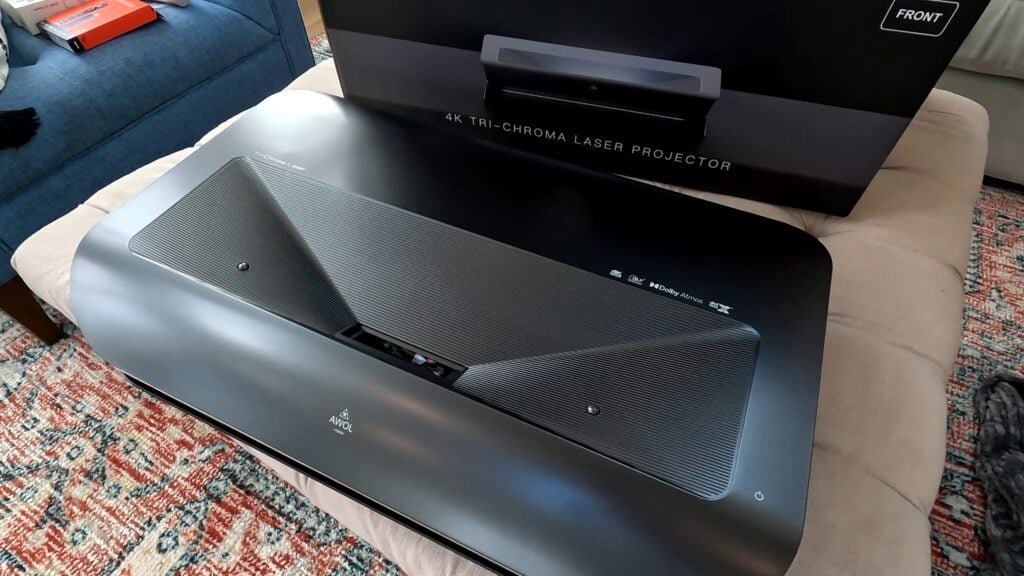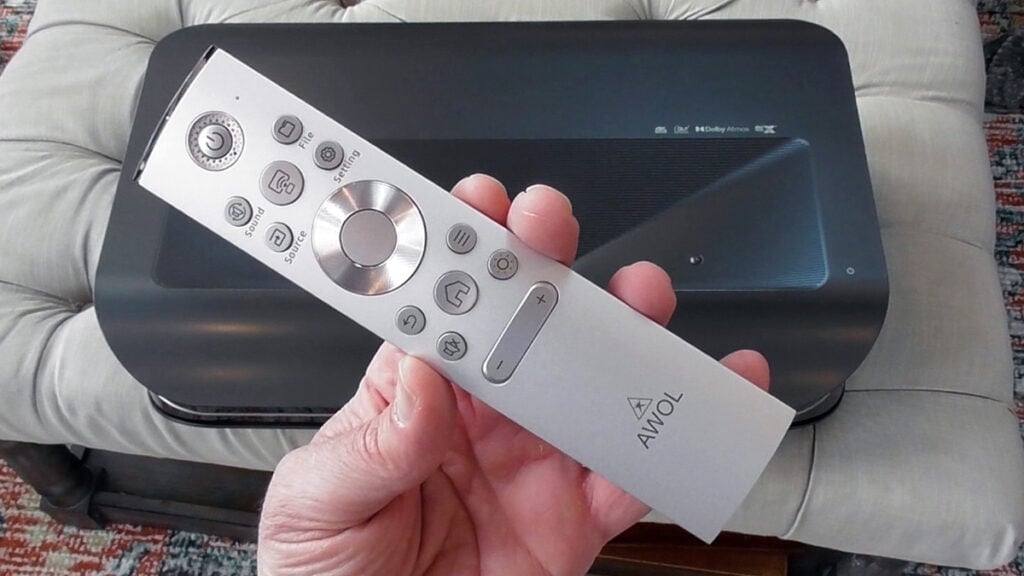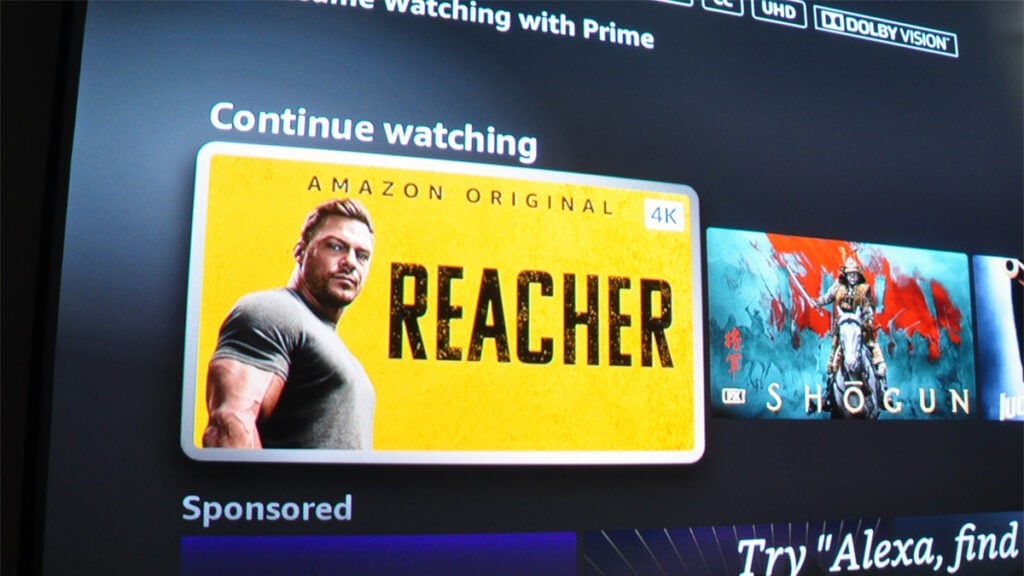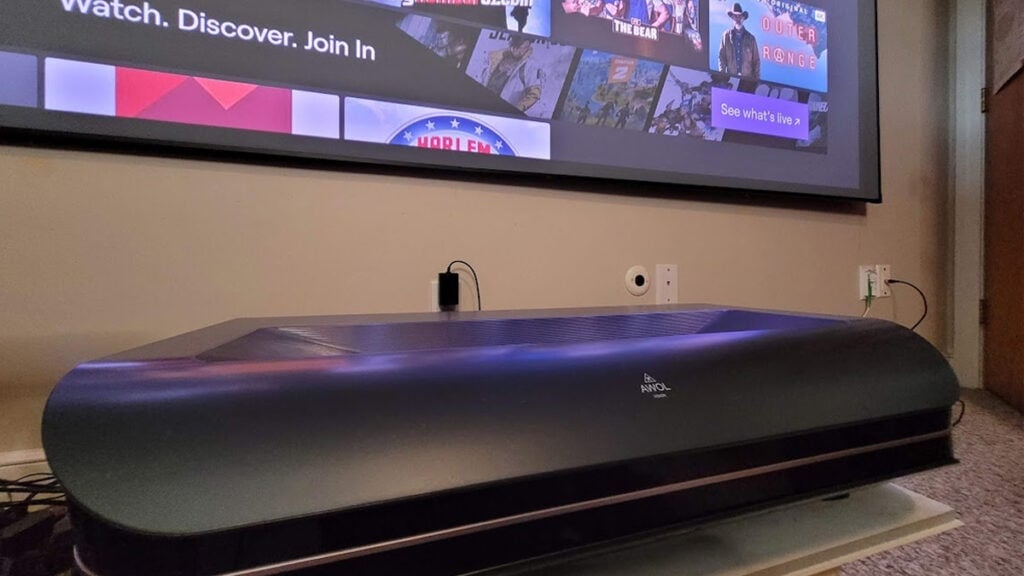Published: April 13, 2024
The AWOL Vision LTV-3500 Pro produces a surprisingly bright 80” – 150” image that brings a movie theater experience into your house. This ultra short throw projector renders an immersive picture with Dolby Vision and other HDR formats.
The UST includes an Amazon Fire TV Stick 4K Max, which includes Netflix and just about any other streaming app you would watch on a Smart TV. However, the best images I saw during testing came from my Blu-ray collection.
Why Choose an Ultra Short Throw Projector?
Ultra short-throw (UST) projectors are made for home theater fans who want big-screen entertainment, but have limited space. Unlike traditional long-throw projectors, you don’t need a significant distance between the screen and projector to get a large image.
If you dream of having a massive TV screen, the AWOL Vision LTV-3500 Pro should be on your shortlist. This latest flagship model supports Dolby Vision, HDR10, HDR10+ and HLG.

You will need both the square footage and budget for it, but in my four weeks of testing out a new LTV-3500 Pro unit, I came up with a number of scenarios why someone might want to consider the investment.
Anyone living in a loft or high-rise apartment with lots of wall space, who can’t get a 100” TV into their building, should consider the ease of moving a UST unit.
Any finished basement or extra room with an open wall could easily become your personal movie theater without the crowds or ticket prices. Watching live sports and playing video games on a 120” screen is both heady and exhilarating.
I haven’t subscribed to the idea that a UST can replace your OLED TV, especially when it comes to brightness and dynamic range capabilities.
But, my experience so far with the LTV-3500 Pro is making me more open to the idea of using a UST as a TV replacement if you become well versed in the tradeoffs.
Key Features and Specifications of LTV-3500 Pro
The LTV-3500 Pro is virtually the same as its predecessor, the LTV-3500, but now supports Dolby Vision along with the previously mentioned HDR formats.
The LTV-3500 Pro also has an upgraded contrast ratio of 2500:1, giving the picture a deep and nuanced palette of blacks. Like other UST projectors, the Pro model is not native 4K, but uses a native 1080p 0.47-inch DLP chip – TI 0.47-inch 4K UHD DMD (Digital Micromirror Device) – to achieve its resolution.
The unit uses a triple-RGB laser instead of a light wheel, cutting down on so-called “rainbow effects” seen in the image.
The Amazon Fire TV Stick 4K Max makes it easy to track down movies and TV shows that support 4K, Dolby vision and other HDR formats. It also ensures that you have a natively supported Netflix app, which is rarely seen on any projectors in the market including units that run on Android TV or Google TV.

The Fire TV Stick is connected via HDMI-CEC so you can use the projector’s remote to navigate through streaming apps like Hulu and Netflix, while maintaining control of the projector’s volume and other settings.
The Fire TV Stick sits in its own enclosed compartment in the back of the projector. It is powered by an internal port on the UST. Under settings, you can make the Fire TV Stick the default source for when the projector is powered on.
When using the AWOL remote to control the Fire TV Stick, you will be using the back button more to exit certain apps and return to the main menu.
Design and Build Quality
The first thing I noticed when unboxing this UST was its size. It’s taller and wider than other units that I have tested. The projector sits at 23.5 inches wide and 15.5 inches from front to back. It’s six inches tall all around.
The LTV-3500 Pro wouldn’t quite fit on the bookcase in my office, but this did not affect my setup. I mention this to illustrate its size.
It should fit fine on most entertainment centers, but doing some measurements in advance is advisable. That’s especially true if you are setting up an ALR screen in a smaller room.
The Ricoh F2.0 lens is described as the largest in the projector industry, and sits in a beveled area on top of the projector.
The chassis is made of a hard plastic shell, but the chrome and black color scheme make it look metallic. A main perk of using a UST projector like the LTV-3500 Pro is that it sits close to a wall, so no passer-by will get caught in the projected image.
Being stationed so close to the screen also gives the projector an advantage of maintaining a high level of brightness on the screen.
It’s apparent from testing out the settings for audio, video and peripherals that the design is well thought out, and aims to please home theater enthusiasts who are sticklers for detail.
Image Quality
The best image I saw while testing the LTV-3500 Pro came from a Blu-ray of “The Thin Red Line.” The shots of aqua blue ocean, when soldiers were first approaching the island of Guadalcanal, really brought forth this projector’s capabilities when it came to color.
It’s surprisingly immersive. Once you watch a Blu-ray on the LTV-3500 Pro, you might find yourself shopping for a new DVD player, or dusting off the one you have.
Streaming movies or TV shows that support 4K Dolby Vision are also impressive. The level of detail with this UST easily surpasses the few other 4K projectors I have tested to date. The great sharpness and clarity is evident in close-up shots of faces, where blacks and subtle nuances are exceptionally pronounced.
I have been watching the entire miniseries, “Shogun” in 4K Dolby Vision on Hulu. Unlike my Blu-ray of “The Thin Red Line”, the landscape of 16th century Japan is darker with grays, black and browns being the most prevalent colors.

Here’s the best way I can describe both the color accuracy and the level of detail you get through Dolby Vision and other HDR formats on this projector: I have owned a 65” Sony OLED TV since 2021.
When watching a Blu-ray, the LTV-3500 is the closest I have come to seeing a projector perform at the level of an OLED TV in terms of brightness and color accuracy. To be clear, it’s not the same, but it’s very impressive.
The brightness will be the first thing anyone notices, especially when you first turn on the unit, and see the AWOL Vision logo exploding with colors.
The brightness is rated at 3,300 ANSI lumens with a “peak brightness” of 3,500 lumens, according to AWOL Vision. To put this in perspective, you can certainly watch this projector with the lights on and still have a great picture. The dimmer the lights, the better.
Watching a Blu-ray movie in a darkened room demonstrates the greatest clarity, realism and precision that this UST is capable of.
Connectivity and Compatibility
There are three HDMI ports total, including one tucked behind a panel for the Amazon Fire TV Stick 4K Max, which is plugged into the UST for power.
At the back of the projector, there is a panel with two HDMI 2.0 ports (1 eARC supported), and single ports for USB, LAN connection, audio input and S/PDIF.
Before getting the LTV-3500 Pro, I had been wondering about its compatibility and ability to stream 4K content on streaming apps. I have tested other projectors that claim to support streaming in 4K, but will default to 1080p (Full HD) when using a streaming service.
The LTV-3500 Pro pulls up 4K HDR supported content (including Dolby Vision) without any problems regardless of the hardware that I use. In fact, you get a readout of your resolution and supported HDR formats at the top of the screen when you start streaming.

Using the Fire TV Stick 4K Max has been a great experience, especially since it earmarks a lot of 4K programming available on Amazon Prime, Disney+ and elsewhere in the main menus.
I also used a NVIDIA Shield, XBox Series X and Roku with the LTV-3500, and remained pleased with the resolution and image quality.
Given that there is already an HDMI port dedicated to the Fire TV Stick, I didn’t have a great need for more HDMI ports. However, if you were connecting a DVD player and game console, or mini PC, then your connections could fill up quickly.
There is a second USB port on the right side of the UST, and I used that port to connect a WD Red hard drive that had some Blu-ray backups stored on it. The movies on the hard drive played really well, even when I used the UST’s own software. When I stopped a movie, it picked up from where I left off.
If you are considering replacing your large screen TV with the LTV-3500 Pro, you don’t need a port for a TV tuner. I watched lots of over-the-air TV channels over Wi-Fi on the LTV-3500 Pro using my HDHomeRun and Tablo.
Sound Quality
The LTV-3500 Pro has 36W stereo speakers that support Dolby Atmos and DTS Virtual X. If you’re not connecting external speakers to the unit, you should be delving into the audio settings to get the most out of these speakers.
There are preset sound modes for movies, sports, music and more. You can select whether to use DTV Virtual X. Adjusting the sound through the equalizer detail settings delivered the best experience.
Of course, your ideal equalizer settings will depend on the size of your room and location of the LTV-3500 Pro.
I regularly record live music from local OTA channels. While playing an episode of “Austin City Limits”, I gradually dialed up the volume to test my equalizer settings. The vocals and instruments remained largely solid and crisp. I was pleased with the dimension and depth of sound that I got from the speakers.
It’s not uncommon for me to easily find some level of distortion when I am testing a projector’s speakers. That wasn’t the case with the LTV-3500 Pro. So, in terms of build quality, I am very satisfied with the speaker’s performance. I did not test external speakers or the optical port, but I plan to in the future.
If you’re not inclined to use the equalizer settings, I think the preset audio for movies was quite good for what I watched, and at times, the music preset delivered decent clarity and depth.
Every projector and UST makes some level of fan noise. The LTV-3500 Pro emits a very low din slightly above a whisper, which is impressive considering the size of the unit and its brightness.
Performance of AWOL Vision LTV-3500 Pro
Setup and Installation
To properly get the entire image on an ALR screen, the projector will need to sit at the proper elevation and distance. I test projectors in a small office with a wall mounted 120” ALR screen.

The LTV-3500 Pro sat about 16 inches away from the wall. The top of the UST is roughly 16” from the floor stationed on top of a couple of solid wooden crates.
You don’t need to be an expert to quickly get an excellent image from the LTV-3500 Pro aligned with an ALR screen. AWOL Vision’s “Correction Chart” tool under the Light tab creates a white frame so you can adjust the UST’s placement.
Once the UST is in place, there is manual keystone correction, and a motorized focused wheel to finish with refining the image. Even if you were a beginner in the home projector realm, the instruction manual that comes with the LTV-3500 Pro had a nice breakdown of how to properly align the image with a screen.
My office has only a seven foot ceiling so I would describe it as a challenging environment to set up a UST. You shouldn’t have any problem aligning and setting up the LTV-3500 Pro in a similarly sized room.
Ease of Use
Anyone who has set up their own Smart TV or streaming device will be able to easily go through the steps of running the projector’s software for the first time and making sure it is up to date.
Once you are done physically setting up and aligning the LTV-3500 Pro, using the UST is as straightforward as any Smart TV.
The remote control puts everything you need to adjust the UST at your fingertips. You can easily get into your picture settings while the menu or picture from the Fire TV Stick is on. This is very helpful if you want to adjust the focus of the lens to get a sharper image.
You can likewise find buttons for any input or setting on the remote, but the button layout is not overly complicated. It follows the style of remote controls seen on most streaming devices with a navigation wheel at the center, volume rocker at the bottom and a mute button at the bottom left.
The remote feels good in the hand, and promptly responds when powering the projector on and off. You might still need the remote control for the Fire TV at times for specific functions, but I stopped using it after a few days.
While you will be using the Amazon Fire TV Stick for streaming, you have the option to play video files from a connected hard drive or home server. You can do this through the File Management tab or All Apps tab.
The projector has 128GB of internal storage and the ability to connect to the web, but I didn’t use these features since I already had what I needed to watch movies and television.
Image and Video Performance
The LTV-3500 really shined with its handling of action movies, and other fast-paced scenes. Most of the time, I will turn off MEMC (Motion Estimation/Motion Compensation) when I am watching a movie because that’s just my preference.
I tested out every MEMC setting by watching the opening race scene in “Furious 7” on Blu-ray. After re-watching the scene using every setting, I watched the scene again with MEMC switched off.
Despite your feelings about MEMC, there were very noticeable degrees to which the LTV-3500 is capable of smoothing out fast-moving action. Overall, it works quite well.
MEMC can be divisive among cinephiles and people who want to only watch movies as the director presented them. With the LTV-3500 Pro, I would either consider putting MEMC on high during an action movie, or not use it at all.
If you’re someone who expects this feature on a projector, you may want to consider a medium or higher setting for live sports, when the movement of cameras is more spontaneous.
There was no motion blur when watching the “Furious 7” scene with MEMC off. It delivered all the jostling camera shots that directors love to use these days for more realistic-feeling sequences without the blur.
Lighting conditions & Picture Quality
I mostly watch TV shows and movies in HD resolution. That includes not only streaming, but live TV and OTA recordings from my HDHomeRun tuner that are in 720p and 1080i resolution.
Being able to watch 4K offerings across Amazon Prime, Disney+ and other streaming services is great. Having 4K programs earmarked makes them easy to find.
Watching the UST in daytime lighting is neat, but honestly, I find myself only doing this when I am watching something casually like the local news. Once you start watching movies and TV shows you care about at a higher resolution, it’s hard to go back.
To see the deepest blacks and everything that a 4K image can offer, turn the lights off. On Disney+, the IMAX Enhanced Marvel films are noticeably more immersive and rich. It’s not simply the aspect ratio. There is a noticeable difference with the background and its contrast with subjects at the forefront of the shot.
The projector comes with a PIR sensor for eye protection. I shut this off shortly after setting up my unit because it would often trigger and flash a warning on the screen when I was walking into the office. I suspect that since the unit was only a couple feet off the floor, the sensor was overly responsive.
The AWOL Vision LTV-3500 Pro is the only projector I have used to date where I could watch TV with ambient lighting. If I am watching a movie or TV series that I am serious about, I will still switch the lights off. The LTV-3500 Pro supports 3D viewing with DLP-Link glasses (sold separately). I have not yet tested out using these glasses, but plan to in the near future.
Gaming and Interactive Use
I connected an Xbox Series X and a mini PC to the LTV-3500 Pro to test out its gaming capabilities.
With my Xbox Series X, you can calibrate the console for the display you are using. It’s also a handy tool to tell you what kind of resolution and frame rate your TV or projector is capable of.
The LTV-3500 Pro delivered 4K UHD at 60Hz and native 1080p at 120FPS along with support for HDR10 gaming. As for watching movies and TV, the LTV-3500 Pro also supports Dolby Vision and HDR10 and 4K 10-bit at 60Hz.
Game play was very smooth with both the Xbox and the Mini PC, even when I was using the cloud gaming option.
Pros and Cons
Advantages of AWOL Vision 3500-LTV Pro
The LTV-3500 Pro supports Dolby Vision and HDR formats and can stream 4K content across streaming devices and TV hardware. Its picture has superior brightness and deep blacks. Beginners in home theater can easily set up this UST with its instructions and “Correction Chart” tool. It operates with very low fan noise, and supports daytime viewing. This UST has a solid construction and works well with streaming devices, DVD players, gaming consoles, and mini PCs.
Limitations and Considerations
Price point is a limiting factor. You will need an ALR screen for best performance, which is an additional cost. Given the size of the screen, you need a room with the square footage to accommodate the screen size, and a flexible layout near the screen, so you can adjust the UST’s elevation from the floor and distance from the screen.
Is AWOL Vision LTV-3500 Pro the Right Choice for You?
My testing did not occur in a theater-blackened room that cinephiles and home theater purists use to judge USTs and other projectors. However, I have been testing a wide variety of projectors indoors and outdoors since 2017.
A UST is a significant investment. Considering that you will want to buy an ALR screen, and have dedicated space in your home, it’s not going to be a purchase for everyone.
Dolby Vision support, and AWOL Vision’s approach to projecting colors with its triple laser technology delivers a lifelike, immersive picture.
Pairing this approach to color with nuanced picture and audio settings makes the AWOL Vision LTV-3500 Pro a sophisticated piece of home theater equipment that isn’t intimidating or overly complicated to operate.
The brightness, clarity, and 4K supported streaming from the AWOL Vision 3500-LTV Pro should automatically put this UST on your shortlist for consideration.
Where to Buy AWOL Vision LTV-3500 Pro
Price: AWOL Vision is regularly priced at $5,999.00.
AWOL Vision UST projectors and screens can be purchased directly from the company’s website, or its store in Delray Beach, Florida. AWOL Vision offers sales and discounts during the year. The AWOL Vision LTV-3500 Pro includes a free 1-year warranty and 24/7 customer service and support.
Recent Updates
April 19, 2024: Clarified the screen size to 80″ to 150″, and points on why someone might choose an UST, and how the MEMC function was tested during the review.
Methodology
I spend hundreds of hours throughout the year conducting hands-on testing of streaming services, including Peacock, DIRECTV STREAM, Fubo, Sling TV, YouTube TV, Hulu Live TV. I do the same rigorous testing for TV antennas and TV-related hardware. Check out the review policy to see how I compare products and services. The Cord Cutting Report is a reader-supported publication, and may earn affiliate commissions when you pick a streaming service through a recommendation. Read our affiliate policy for more information.